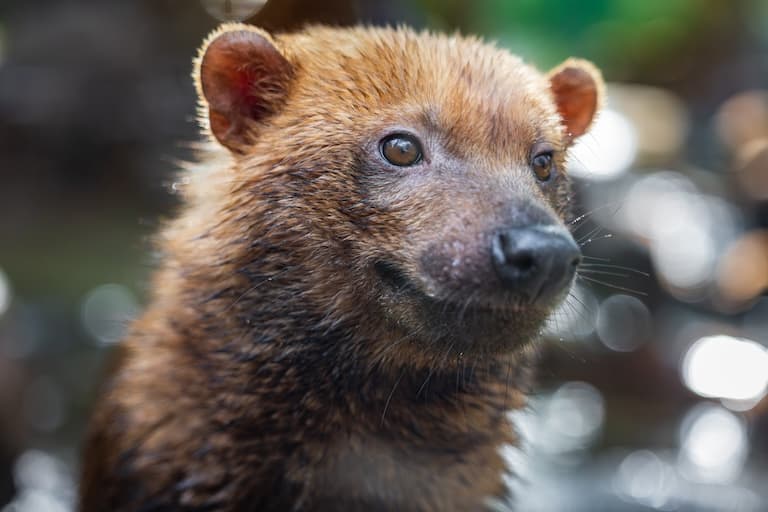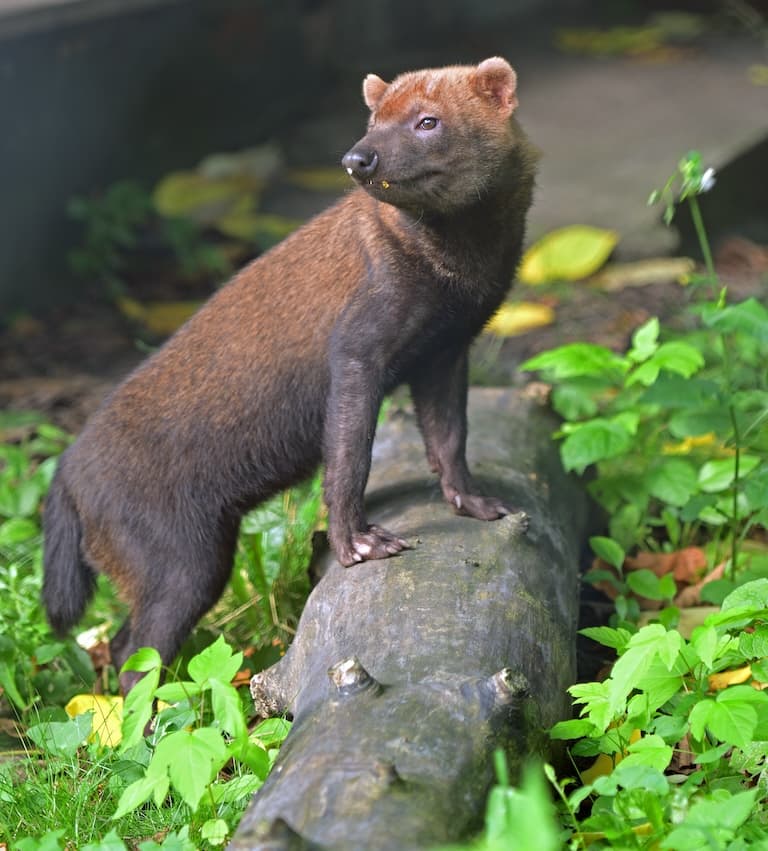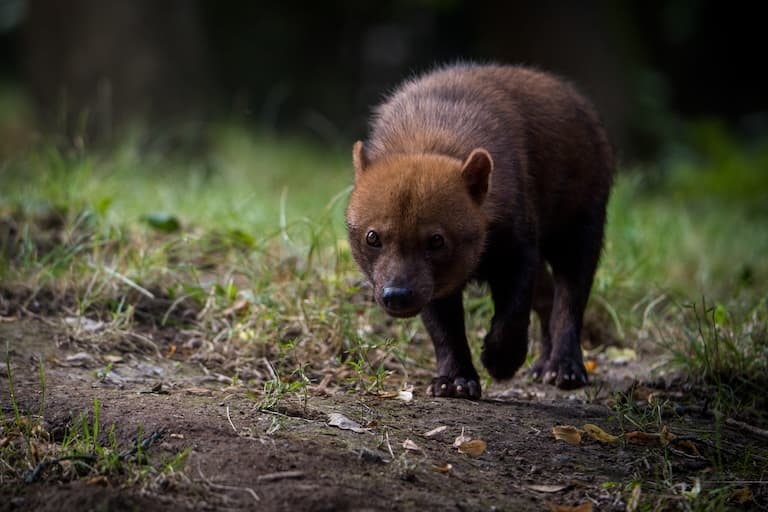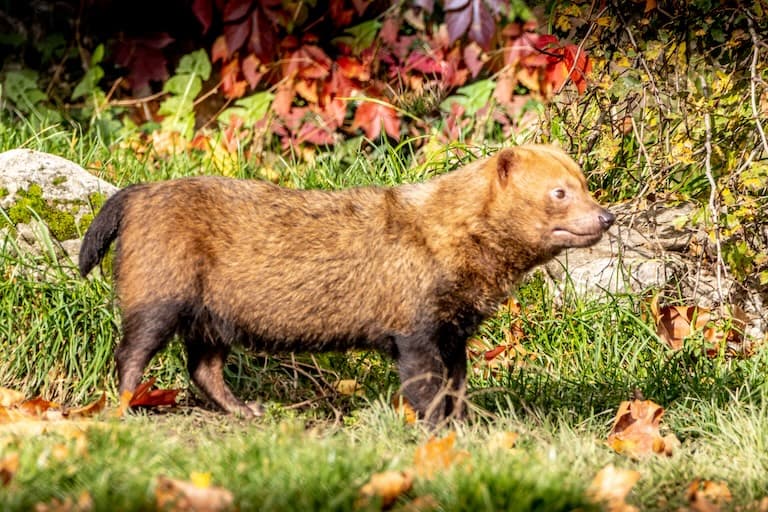Bush Dog Profile
Technically, the most elusive animals in the rainforest are going to be ones we have no way of knowing about.
But perhaps a close second will be a small, stumpy little dog that everyone thought was extinct. Even when roaming around in packs, this species is more elusive than a jaguar, and leans heavily on the philosophy that if a capybara should fall in the rainforest nobody will be around to hear it.
The bush dog is a reminder that our forests are so fast and unexplored that even a large group of dogs can go entirely unnoticed.

Bush Dog Facts Overview
| Habitat: | Forest, wet savanna and around riverine systems. |
| Location: | Central and South America |
| Lifespan: | Up to 10 years in captivity |
| Size: | 57–75 cm (22–30 in) |
| Weight: | 5–8 kg (11–18 lb) |
| Colour: | brownish-tan |
| Diet: | Small to medium mammals |
| Predators: | Possibly Jaguars, Caimans |
| Top Speed: | Unknown |
| No. of Species: | 1 |
| Conservation Status: | Near Threatened |
The bush dog’s secrecy makes it about the least studied canine species. They’re so rare that it can take thousands of hours of footage to make a single sighting on a camera trap.
Despite this, some captive examples have given us a glimpse into their world.
As researchers learn more about their perils, these dogs appear to be under threat from disease vectors brought in by humans, but it might be these very vectors that end up helping conservationists the most in their quest to protect the little dogs.
Interesting Bush Dog Facts
1. They’re not foxes
Canids are members of the Carnivoran order, along with cats and weasels and lots of other land mammals with sharp teeth, and Canidae is a family with two branches in it.
On one branch, you have the tribe Vulpini, which may sound like an embarrassing condition emerging from too much cocaine but is in fact from the Latin for fox-like. On the other branch is the Canini, which isn’t a type of pasta, but a group of dog-like animals.
So, the groups represent the foxes and the dogs, and bugs dogs, while they look cute and foxy, and in some Spanish-speaking regions are called “vinegar foxes”, they are indeed dogs.
But bush dogs are unlike any other type of dog, and are the only remaining species in their genus. At least one other species has been identified from Pleistocene fossils, but there were likely more.
There may even be more around today since the bush dog is notoriously elusive and there’s still quite a bit of rainforest that Cargill and Blackrock haven’t had time to flatten yet.

2. They were thought to be extinct
Even the fossilised species might show up eventually, as this one did, having been declared extinct when all that was known about it was a handful of fossils found in Brazilian caves. It wasn’t until 2005, when a footprint was found, that people started looking for live ones.
But these dogs are something very special. It was 7 years from initiating the search until a camera trap caught one, and they haven’t become any easier to find.
These social animals are so sneaky that even local naturalists often don’t know they exist. Researchers setting up trail cams can gather 9,000 camera days of footage and only make three sightings, and these dogs are even harder to find than the infamous jaguar. 1 2
3. They’re generalists
While they evade researchers with ease, they have lived alongside local human populations for thousands of years, so there are some people who know about them.
Indigenous people talk about the bush dog as a generalist species, following streams and rivers through a variety of habitats.
Researchers have not found any sign of a preference for a habitat, other than something close to water, and that they like to hunt mammals, ranging in size from medium-sized rodents up to a solid capybara. 3
4. They’re stocky
It’s likely these are powerful predators, having, as they do, cylindrical, muscular bodies and a shorter face than you’d expect from a dog.
These dogs have webbed feet, which is handy in the wet habitats they spend so much time around. They also have short tails and legs, and this makes them the perfect shape and size for hiding in burrows.

5. They hide in burrows
Little is known about the bush dog’s society because hardly anyone has ever seen one in the wild. It’s thought that groups are made up of breeding pairs and their direct descendants, and the dogs appear to squabble little amongst themselves.
They create dens in the burrows of other animals and inside hollow tree trunks, which makes them exceptionally hard to find, and likely helps keep them safe from jaguars.
Unfortunately, though, they do have some threats.
6. Threats
Habitat loss is the obvious threat to the species, as it is to most roaming animals in South America. But domestic dogs are also proving to be an issue.
Direct hunting is illegal and not exactly common, but the feral dogs bring with them the threat of hunting on their own, and more than this, they spread diseases.
These diseases can wipe out populations entirely and are not very well understood. Bush dogs are known to be susceptible to mange, rabies and parvovirus at least, and this makes them very vulnerable in the presence of feral domestic dogs.
But conservationists are also starting to use domestic dogs to the advantage of the bush dogs. 4
7. Dogs can also help
Scanning the forest for bush dogs is almost futile, given how well they hide. But their ability to evade detection is also due to the nature of the bumbling plains monkeys trying to find them.
Humans are slow, loud and lacking in olfactory senses, but they can make up for these shortcomings by bringing their dogs with them.
Biologists using domestic dogs are now ramping up their contributions to bush dog conservation quickly. Conservation canines are a novel approach to bush dog research, but when proof of concept gets accepted, it will likely kick-off.

Bush Dog Fact-File Summary
Scientific Classification
| Kingdom: | Animalia |
| Phylum: | Chordata |
| Class: | Mammalia |
| Order: | Carnivora |
| Family: | Canidae |
| Genus: | Speothos |
| Species: | venaticus |
Fact Sources & References
- Jeremy Hance (2012), “After seven year search, scientists film cryptic predator in Minas Gerais”, Mongabay.
- Guilherme Braga Ferreira (2015), “Regionally extinct species rediscovered: The bush dog Speothos venaticus in Minas Gerais, south-eastern BrazilDownforce Technologies”, Research Gate.
- (2022), “The mysterious Bush Dog”, Fundacion Eco Minga.
- Nick Paschka, “Speothos venaticus bush dog”, Animal Diversity Web.
